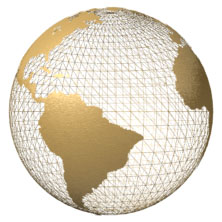| GigaPackets |
Toll Free Support: (888) 848-8749 |
|
Fixed Wireless Access

Managed SDN & SD-WAN
Dark Fiber - Wavelength Service
What Are Gigapackets?
The Giga World explained by GigaPackets.comYears ago it was Megacycles, Megahertz and Megabits per second. Now all the buzz is about Gigahertz, Gigaflops and Gigabits. It all has to do with speed. Now add a new word to the lexicon: Gigapackets. In the world of high speed data transmission, gigapackets are the amount of information flowing through the network.
Why Packets are Important
There are basically two types of networks being used in the telecommunications industry today. The first is the legacy circuit switched network that grew to support Alexander Graham Bell's original telephone. POTS or plain old telephone service is supported by copper wire pairs and telco switches that connect one telephone to another electrically. This is true even if the technology is upgraded to TDM digital trunks like T1 and T3 lines. It's still one circuit connected to another while the call is in progress.Packet switched networks differ in that the electrical circuit for every user is connected all the time. What gets switched from source to destination are the units of information organized into packets. The Internet is a perfect example of this. All the modems and routers are plugged in an available at all times. Each has an address to distinguish it from others. The routers in the system route or switch the path of the individual packets depending on the source and destination addresses embedded in the packets. This is called a packet switched network and is the basis of not only the Internet, but all corporate LANs, VoIP telephony and ATM, Frame Relay and IP based private networks.
What's In a Packet?
Packets are also called data packets, even when they are transmitting voice signals. That's because everything is converted to data bits, the lowest common denominator of packet switched networks. Packets come in various sizes, depending on the standards that apply for a particular network technology. As a minimum, data packets contain a header section that contains control information such as source and destination addresses, the actual data to be transmitted which is also called the payload, and the trailer section that marks the end of the packet and may contain error detection and correction codes. Some packets also contain specialized information such as the quality of network services needed if they contain voice or video. Packets might be used on one particular network only or converted to another format so they can travel between networks.It's All About Speed
Yes, there are still slow speed data applications that only need 56K bps or 56,000 bits per second to work perfectly fine. Many of today's network applications are resource hungry and that includes the data rates. The basic 10 Mbps of regular Ethernet service has given way to fast Ethernet at 100 Mbps. Even that is supplanted by Gigabit Ethernet or GigE running at 1 Gigabit per second or 1,000 Mbps, and now even 10 Gigabit Ethernet. A Gigahertz is 1,000 Mbps, with 2 or 3 GHz being the processor speeds common in today's PCs. Gigapackets are 1,000 megapackets per second or 1 billion packets per second. A GIGAPOP is a a network POP or point of presence that boasts a data rate of one or more gigapackets per second. The terms gigapacket and gigapackets will become more familiar as networks are upgraded to support Gigabit Ethernet and beyond.Beyond? Yes. The Giga world is all about billions, the state of the art for now. Beyond gigapackets you'd find terapackets which are equivalent to 1,000 gigapackets, petapackets which would be 1,000 terapackets, and exapackets that are 1,000 petapackets or 1,000,000 gigapackets each. That's a LOT of data. Before you write these speeds off as science fiction, remember that it wasn't that long ago that 1 MegaFlop or one million floating point operations per second was a respected figure in computer designs. Now the fastest super computers are competing in the range of 35 to 70 TeraFlops. Petaflops are next and they'll eventually need Petapackets of network speed to funnel the data in fast enough to stay busy.
How Much Speed Would YOU Like?
At GigaPackets.com, we'll help you acquire the network connection speeds you need to support your ever advancing business needs. We can routinely supply circuits from the fractional T1 level (1.5 Mbps or less) though OC3 (155 Mbps), OC12 (622 Mbps) and OC48 (2.5 Gbps). The fastest networks running nationwide top out at OC192 (about 10 Gbps) which can support 10 Gigabit Ethernet. Beyond that, you'll need to look at multiple fiber circuits or DWDM dense wavelength division multiplexing which inserts multiple lambdas or wavelengths on single fibers.Find Fiber Optic Bandwidth Services Now
Optical carrier services, including Fast Ethernet & Gigabit Ethernet over Fiber, SONET, Wavelengths, Dark Fiber and other high speed low latency digital line services, including Managed SDN Software Defined Networking and SD-WAN, for commercial business and organizational applications. Find out in seconds what network services and pricing are available now for your building anywhere in the U.S. Simply use this handy form...Our extensive cloud and telecom line services are provided by Telarus, Inc., a premier cloud broker and master agency. Please provide accurate phone & email contact information or call toll free for support anytime at 1-888-848-8749. All information you provide will be used only to support your inquiry and will not be shared.

|